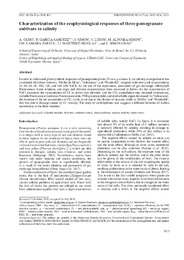Resumen :
In order to understand photosynthetic responses of pomegranate plants (Punica granatum L.) to salinity, an experiment was
conducted with three varieties, ‘Mollar de Elche’, ‘Valenciana’, and ‘Wonderful’, irrigated with seven salt concentrations
(0, 40, 60, 80, 100, 120, and 140 mM NaCl). At the end of the experiment, parameters of gas exchange, chlorophyll
fluorescence, water relations, and sugar and chloride concentrations were measured in leaves. As the concentration of
NaCl increased, the concentration of Cl−
in leaves was elevated, and the CO2 assimilation rate, stomatal conductance,
variable fluorescence/maximum fluorescence ratio, PSII quantum yield, and total soluble sugars decreased. In ‘Valenciana’,
the decrease of the net assimilation of CO2 could occur due to the closure of stomata, while in ‘Mollar’ and ‘Wonderful’,
this was due to damage caused by Cl−
toxicity. The study of carbohydrates also suggests a different behavior of carbon
metabolism in the three varieties.
|
 La licencia se describe como: Atribución-NonComercial-NoDerivada 4.0 Internacional.
La licencia se describe como: Atribución-NonComercial-NoDerivada 4.0 Internacional.
.png)
